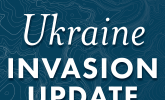Putin’s Victory Day Speech Forgoes an Opportunity to Escalate Russia’s Invasion of Ukraine
May 9, 2022 - ISW Press
Russian President Vladimir Putin used his May 9 speech to praise ongoing Russian efforts in Ukraine and reinforce existing Kremlin framing rather than announce a change. He did not announce an escalation or declare victory in the Russian war in Ukraine. May 9, Victory Day, is Russia’s most important patriotic holiday and commemorates the Soviet victory in the Second World War, known in Russia as the Great Patriotic War. Putin’s much-anticipated speech was a ready-made opportunity for him to alter the Kremlin’s current framing of the war in Ukraine or announce a policy change. Putin had three general options for his Victory Day address: declare some sort of Russian victory, make a policy change to ramp up the war effort in some way (such as by calling for a larger-scale mobilization or formally declaring war on Ukraine), or what he chose—to pursue a steady state narrative and reinforce the Kremlin’s existing framing (and resourcing) of the war.










